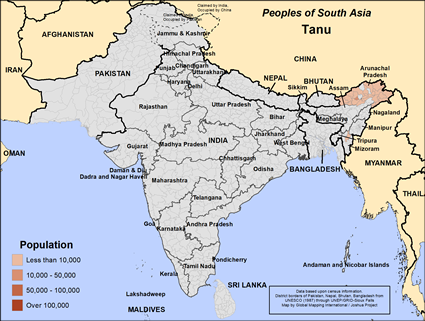Tanu in India

Photo Source:
Arif Siddiqui - Wikimedia
Creative Commons
|

Map Source:
People Group data: Omid. Map geography: UNESCO / GMI. Map Design: Joshua Project.
|
| People Name: | Tanu |
| Country: | India |
| 10/40 Window: | Yes |
| Population: | 44,000 |
| World Population: | 44,000 |
| Primary Language: | Apatani |
| Primary Religion: | Unknown |
| Christian Adherents: | 21.68 % |
| Evangelicals: | 0.00 % |
| Scripture: | New Testament |
| Ministry Resources: | Yes |
| Jesus Film: | No |
| Audio Recordings: | Yes |
| People Cluster: | South Asia Tribal - other |
| Affinity Bloc: | South Asian Peoples |
| Progress Level: |
|
Introduction / History
The Apatani (or Tanu, as they describe themselves) are a well-known tribal community in Arunachal Pradesh, India.
Their society is made up of several clans: Dani, Dora, Dumper, Dusu, Haj, Hidi, Kago, Kimte, Miri, Nada, Nemko, Nemp, Nendin, Pemu, Plangang, Puna, Pura, Taku, Taro and Taru. These clans are divided up into two endogamous units. Traditionally, the clans of the Mora or Guchi division perform services for the clans of the Mith or Guth division.
Europeans first contacted the group in 1897. After subsequent contacts and construction of an outpost by the Assam Rifles in 1948, the Apatanis attacked. Two of their villages were burnt in retaliation.
They live in the Lower Subansiri district of Arunachal Pradesh.
What Are Their Lives Like?
The Tanu are known for their use of large nose plugs by the women, although that practice is in decline, especially among the youth. The women were considered to be the most beautiful ones among all the Arunachal tribes. Men and women alike tattoo their faces, although this too is falling out of popularity. They are beginning to follow more modern traditions now, yet much remains intact of their customs.
They live in bamboo houses on stilts. The women cultivate vegetables and do many household chores as well as spinning cotton and weaving. Men also have a part in overseeing the agricultural aspect of the village and are seen as heads of their families. Their wet rice fields are irrigated using an effective system of canals.
A sacred pole and a sacred platform are constructed every four years and used for festivals and community events. They celebrate the festival of Myoko in March and the festival of Murung in January. Another very important festival, called Dree, is celebrated in many towns in Arunachal Pradesh.
What Are Their Beliefs?
The Tanu follow the Donyi-Polo or Danyi-Piilo faith. They venerate the sun and the moon. They also believe in evil spirits who are to be appeased with animal sacrifices accompanied by chants lasting anywhere from a few minutes to a few hours.
There is a sizable Christian minority.
What Are Their Needs?
Tanu Christians need to be discipled and sent out to disciple others.
Prayer Points
Pray for Tanu disciples who will become disciplers of entire families.
Pray for the Holy Spirit to move in power throughout Anunachal Pradesh.
Pray for powerful Tanu churches that will plant other churches.